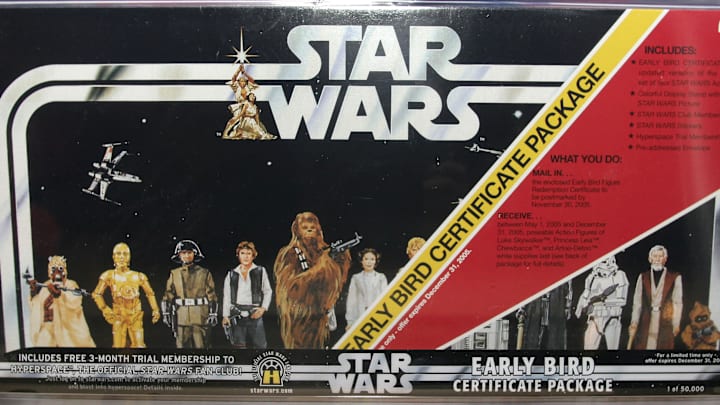It's hard to imagine a child's face lighting up at the sight of an empty cardboard box staring back at them from under the Christmas tree. But in 1977, young Jedis-in-training were so hungry for anything Star Wars-related that even an I.O.U. was something to get excited about.
When George Lucas's intergalactic gamble first hit screens in May 1977, no one knew quite what to expect—especially the film's toy-making partner, Kenner. Instead of flooding the market with action figures and dolls for a movie that could very well end up being a flop, the company decided not to manufacture any toys right away. Unfortunately, there wasn't just a demand for Star Wars toys that year; there was an outright fever that took the company completely by surprise. And with Christmas just a few short months away, the ill-prepared Kenner needed to act—fast.
For Christmas 1977, Kenner sold @StarWars certificates to get toys in the future. Empty Box Campaign! #ForceFriday pic.twitter.com/ViO3r9ZwUs
— Good Morning America (@GMA) September 3, 2015
Realizing it would be impossible to get a full line of Star Wars toys manufactured in time to meet the needs of the holiday season, a Kenner executive named Bernard Loomis knew he had to improvise. Instead of simply releasing a proper toyline in 1978 and missing out on the Christmas rush, Loomis came up with what is now known as the "Early Bird Certificate Package" (or more colloquially as the "Empty Box Campaign") to satisfy this sudden, rabid fan base.
Basically, parents would go to their local toy store and pay $7.99 for a thin cardboard package, about the size of a manila envelope, with painted renderings of the proposed 12-figure Star Wars toyline that Kenner was promising to release in the months ahead. The cardboard kit could be turned into a display diorama for all the figures, which—at that point—only existed in theory. And since the word "diorama" isn't quite enough to satisfy a kid on Christmas morning, the kit also contained the all-important mail-in certificate promising the recipient would get the company's first four figures—Luke Skywalker, Princess Leia, R2-D2, and Chewbacca—delivered right to their homes between February and June 1978.
Kenner limited the supply of this glorified pre-order campaign to 500,000 kits, none of which were to be sold after December 31, 1977 in order to really manipulate the holiday market.
In an attempt to soften the blow of what was essentially nothing but a bunch of cardboard under the tree, Kenner sweetened the pot by including some stickers and a Star Wars Fan Club membership card. After months of waiting, kids everywhere would come home from school and be greeted by their delayed Christmas gift: four figures, along with foot pegs to fit them into their display stand. Eventually the entire first line of Star Wars toys came out in 1978 and could be purchased in stores, whether you mailed in a certificate or not.
From 1978 to 1985, Kenner never again doubted the power of the Star Wars toy line. In that time, the company released a robust roster of more than 100 different action figures based on the film series, scraping the bottom of the barrel of Lucas lore along the way with obscurities like Dengar and General Madine. The company went from having no toys on the shelf in 1977 to having every side character, prop, and vehicle recreated in plastic in just a few years.
Nowadays, intact Early Bird Kits go for big money on the collector's market, especially if they still include the original certificate kids were supposed to mail back (prices in the $4000 to $8000 range are pretty standard). But the biggest winner of this whole stunt, as usual, was George Lucas.
When signing on to direct Star Wars at 20th Century Fox, Lucas agreed to work for just $150,000, as opposed to the $500,000 he was set to earn. In exchange for the pay cut, the director asked for two things: The rights to any sequels to the movie and the rights to all the merchandise, including the toys. Believing Star Wars to be just another science fiction movie, Fox happily agreed to the reduced salary. That empty box under countless Christmas trees was the start of what would become Lucas's $20 billion merchandising empire.
This article originally ran in 2016.
